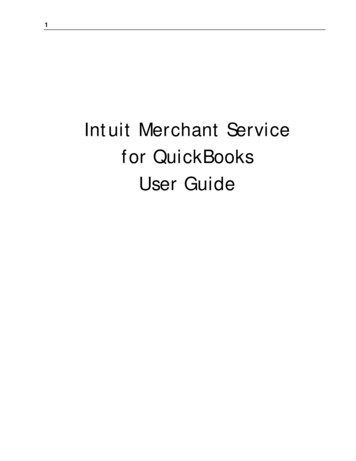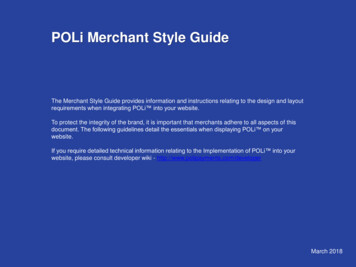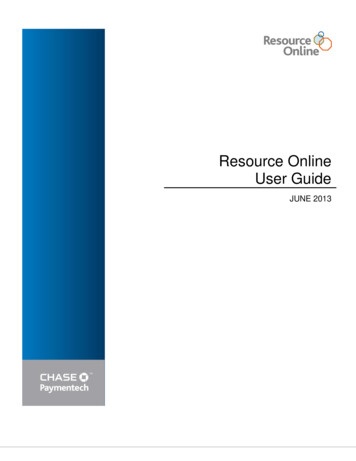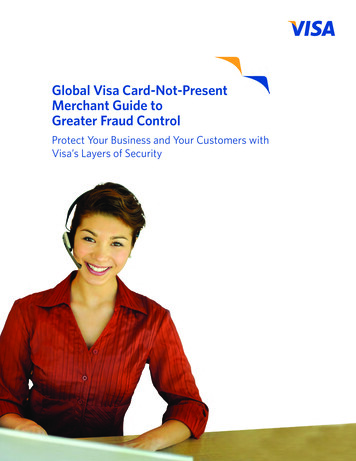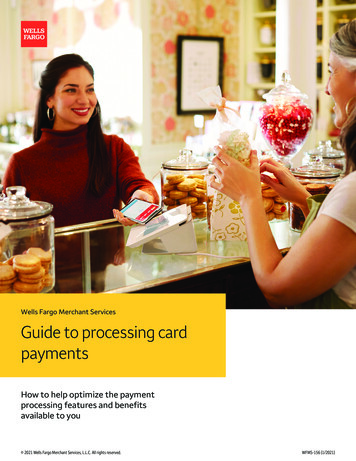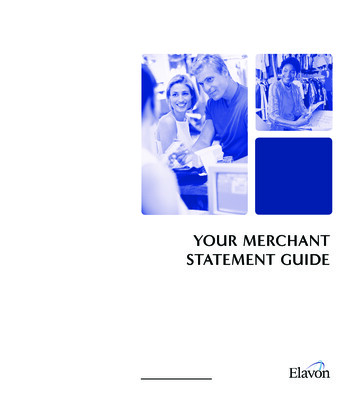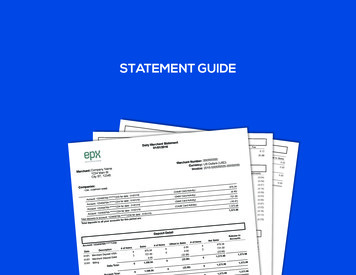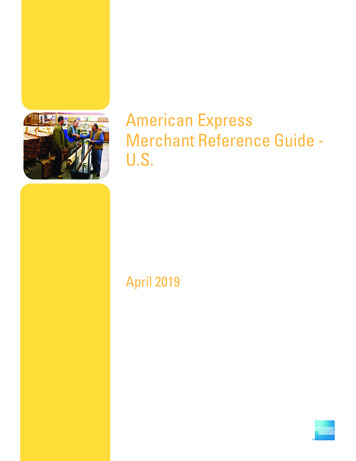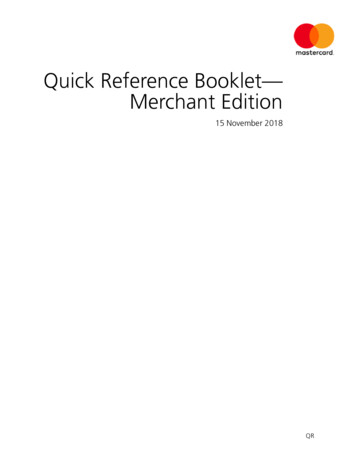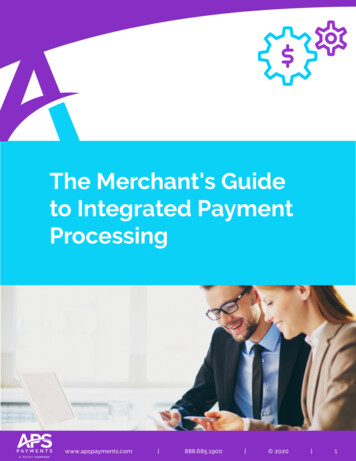
Transcription
The Merchant's Guideto Integrated PaymentProcessingwww.apspayments.com 888.685.1900 2020 1
Table of ContentsIntroduction.3Who's Who of Payment Processing.4The Basics of a Credit Card Transaction.7Fees and Pricing Models.9B2B Level 3 Savings.15Benefits of Integrated Payments. 17Selecting a Payments Provider.19Next Steps. 22Glossary - Key Payments Terms. 23www.apspayments.com 888.685.1900 2020 2
IntroductionMany business owners and rising star entrepreneurs hit roadblocks when it comes to creditcard processing. They understand money, they understand payments, they know that it isin their best interest to secure the best rates possible anytime money changes hands. Theproblem? Most professionals, business owners, and entrepreneurs alike all become expertsin their business and their respective fields – not in payments.Now you can sigh a deep breath of relief because you don’t have to know everything aboutpayments in order to get the best rates for your business. All you need is a friend in theindustry.This guide will go through some of the finer points of credit card processing, importantdefinitions, and how the whole ecosystem works but all you really need to take away is whatto look for to get the right payment solutions provider for your needs. Easy enough? Let'sget started!www.apspayments.com 888.685.1900 2020 3
The Who's Who of Payment ProcessingThere are a lot of moving parts with each credit card transaction with the parties involved.Knowing and understanding the players of the credit card processing industry can equipyour business for success when analyzing the best solution to meet your needs.Acquirer: The acquirer, also known as acquiring bank, is the bank or financial institutionthat processes credit or debit card payments on behalf of a merchant. The acquirer allowsmerchants to accept credit card payments from the card-issuing banks through the cardbrand franchise. The acquirer is the financial institution that maintains the merchant’s bankaccount and is the only institution in the process that truly handles the merchant’s money. Incontrast, the Core Processor handles the transaction data and the Merchant Service Provider(MSP) facilitates signing up merchants to accept network-branded cards and servicing theiraccount. Underwriting can occur with the acquiring bank or the Merchant Service Provider orboth.The acquiring bank plays a central role in the settlement and clearing process. The coreprocessor passes the merchant’s transactions along to the card brands and the total depositamounts to the acquiring bank in order for the merchant to receive payment. The acquirerdepends on the core processor to pass along the merchant transactions.The advantage to working with a payment solutions provider/merchant service provider isthat they can work with any bank, and, if the MSP or payment solutions provider (PSP) workswith multiple banks, the merchant can change banks and may not have to change credit cardprocessing systems. The PSP is able to shop around for the best pricing and solutions for theirmerchants. If the merchant is processing directly with a bank, they will have to know where toget the best rates, secure those rates for themselves, and ultimately change both accountsif they ever want to switch to a new bank. The right PSP’s are in actuality more flexible, lowerpriced, and have more available solutions for their merchants.Cardholder: The cardholder is the consumer purchasing goods or services from themerchant. They get approved for a card by the issuer. The issuing bank is a licensed memberof Visa or MasterCard and holds agreements with, and issues cards to consumers who apply.www.apspayments.com 888.685.1900 2020 4
Core Processor: Merchants require a core processor to pass the details of each cardtransaction to the consumer’s issuing bank for authorization. Within seconds, the processorwill send the response back to the merchant as to whether the card is authorized or declined.Finally, the core processor sends the details of the captured and settled authorizations tothe merchant’s acquiring bank. Core processors only work with banks that they are set upwith. Merchants must process with a core processor that their acquirer uses. Merchants donot need to seek a core processor on their own as this will be provided by the acquirer orpayment solutions provider.It is important to understand the difference between a core processor, such as GlobalPayments/TSYS and Fiserv/First Data, and a payment solutions provider/merchantservices provider. Even though the latter are sometimes referred to simply as “processors”, itis not correct terminology. Payment solutions providers can be more advantageous for yourbusiness than directly engaging a core processor as they are able to maximize the solutionseach core processor has to offer in the merchant's favor. The payment solutions providerworks as a guide through the payments process.Gateway: Payment Gateways serve to protect sensitive consumer data during thetransaction process and allow the secure transfer of payment data between the buyer andthe seller. The Gateway is a merchant service that securely sends credit card informationfrom a website or brick-and-mortar store to the payment networks for processing and thenreturns transaction details and responses from the payment network back to the merchant.Gateways are required to provide a secure connection to transmit information and maintainsafety compliance and standards. A quality payment gateway will be easy to use, andwill provide essential functions, such as encryption and security of all data as well asauthorization requests and fulfillment.Independent Sales Organization (ISO), Merchant Service Provider (MSP),and Payment Solutions Provider (PSP): The companies that manage credit cardprocessing for merchants are referred to as ISOs, MSPs, and PSPs. The terms can be usedalmost interchangeably, with some key differences:ISO is a loose term for any third-party sales representatives who represent the issuingbanks for Visa. MSP is the term used for Mastercard transactions. PSP is a neutral term for acompany that provides payment solutions to merchants and is not beholden to a specificcard or bank.www.apspayments.com 888.685.1900 2020 5
Independent Software Vendors (ISVs): ISV’s are software developers who buildthe integrations between the payment gateway and the accounting software, eCommerce,and/or point-of-sale (POS) software and offer various payment processing features andfunctionality.Issuer: The issuer, also known as the account issuer, or issuing bank, is the bank orfinancial institution who offers the credit or debit card to the consumer. They underwrite thecardholder, set the credit limit, and issue the card agreements. They pay for the transactionon behalf of the cardholder and collect payment from the cardholder. Issuers also providecustomer service and handle issues of fraud, lost or stolen cards to the cardholder. Theissuer is responsible for verifying the cardholder data and authorizing the amount of thetransaction based on available funds. Some of the main issuing banks are Bank of America,Chase, US Bank, Wells Fargo, and Discover. American Express is both a card network and anissuer. Issuers are not in the business of processing the transactions.Merchant: A merchant is any type of business who sells goods or services to consumers.Credit cards are the most common payment method used for these transactions. Merchantsrequiring a Merchant Account with a payment solution provider in order to process payments.Network: The credit card network, also known as the payment network, paymentprocessing network, card association, or card brand is the bridge between the cardholders,merchants, and issuers. They set the interchange rates and assessment fees that themerchant pays with each transaction. These fees are non-negotiable and consistent forevery business, every acquirer, and every issuer. The credit card network includes brands likeVisa, Mastercard, American Express, and Discover.These definitions cover the 9 major players you need to know in order to understand thefundamentals of payment processing. The following section will illustrate how they interacttogether to complete the transaction process.For additional terms and glossary definitions, skip to the end of this guide.www.apspayments.com 888.685.1900 2020 6
The Basics of a Credit Card TransactionBelow is a simplified example of the card payment process:When a consumer makes a purchase, their card information immeadiately enters themerchant environment and begins the steps to processing a transcation. All the aboveboxes in white show the transaction process (explained further on page 8) and the boxes ingrey show the steps for settlement.www.apspayments.com 888.685.1900 2020 7
The 9 Basic Steps of a Single Credit Card TransactionSTEP 1: The customer uses a credit card to pay a merchant. The transaction andcredit card data is collected within the merchant environment with the specificpayment systems they have in place, including point-of-sale (POS), eCommerce, orindependent software vendors.STEP 2: The data is transmitted by the merchant through the Merchant ServiceProvider (MSP) or Independent Sales Organization (ISO) software via the Gateway tothe Core Processor.STEP 3: The processor sends the transaction details to the appropriate cardnetwork.Step 4: The core processor checks the status of the consumer’s account throughtheir direct integrations into the card brands networks. The card brands hold all ofthe consumer account card balances on behalf of the consumer’s issuing banks(issuers) that lie within the card network.STEP 5: The card network sends the approval code through the core processorand merchant environment systems back to the merchant to complete the sale.STEP 6: The card network sends the transaction details to the consumer’s issuingbank (issuer).STEP 7: For settlement, the merchant sends a batch of the daily transactions to thecredit card core processor to provide the transaction details to the card brands andthe merchant acquiring bank.STEP 8: The merchant’s acquiring bank deposits the funds in the merchant’saccount. The acquiring bank is the only key player allowed to directly send money tothe merchant for transactions made, per card brand regulations.STEP 9: The consumer’s issuing bank sends the consumer a monthly statement ofcredit card transactions and the issuing bank gets paid from the consumer.www.apspayments.com 888.685.1900 2020 8
Fees and PricingAre you getting the best rates with your merchant services provider? How would you know?The cost of processing credit cards can get out of hand if you are not able to keep a closeeye on your monthly merchant statement. If you think your monthly credit card processingmerchant statements are confusing, you are not alone. It is very possible that your merchantstatement is confusing by design. If you look into your processing fees and start rateshopping, you might find some good reasons to switch to another processor.When it comes to lowering your credit card fees, knowledge is power. There are severalways to lower your fees -- sometimes upwards of thousands of dollars. For instance, youcan try to negotiate for lower fees with your current credit card processor. Before you caneffectively negotiate or shop around, it is important to first review some basics on how tointerpret your statement, so you can understand the different fees and costsWhere did my money go? An explanation of a fee.If you have fees that are not clear on your statement, it is a good idea to contactyour payments provider and ask them to explain the fees charged.Not all merchant statement fees are negotiable. It is important to understand the differencebetween Base Cost vs. Markups.Base costs – The majority of your costs should be these; the hard costs of processing creditcards for your merchant account. A typical percentage of base cost is 75%-80% of your totalcost. Here is an example of a base cost:Transaction fees – This is a flat fee that is charged for every transaction. You agreedto the rate when you signed up.Markups – Markups are also called merchant discounts. The markup costs are like payingthe retail price of the cost of processing the card. A reasonable markup cost should bearound 10%-25% of your total bill. Here are some examples of markup fees:Monthly fees – The monthly fees are not usually labeled as monthly fees on yourstatement. You may not need all the services your credit card processor is chargingyou. Check with your processor if you have questions.Miscellaneous fees – These fees can be added at any time for a variety of reasons.www.apspayments.com 888.685.1900 2020 9
Who gets the fees?The fees that a merchant is charged for payment processing can go to a number ofproviders. Fees from the card issuers and the card brand are non-negotiable and remainconsistent across merchant service providers. MSP/ISO may have some fees that arenegotiable. For example, a payment processing provider that has their own gateway caneliminate gateway fees for their clients.Card IssuersCard BrandsPayments Providers(fees non-negotiable)(fees non-negotiable)(some fees negotiable)Assessment FeesSales DiscountInterest RateAuthorization/Transactions / Batch feesFANFInterchange FeesPCI Compliance FeesAVSwww.apspayments.com NABUSupport, Statement,Gateway, Fees.NetworkAdditional Fees(Minimum fees, etc)888.685.1900 2020 10
Processor Pricing modelsHistorically, credit card processing was sold and distributed through credit card companies’network of banks, but quickly they began outsourcing processing to third-parties (MSPs).The company who sets the rates for your credit card processing can be called by manynames: merchant services provider (MSP), payment solutions provider (PSP), independentsales organization (ISO), or even just “credit card processor” although that term shouldbe used most often to describe the Core Processor that connects merchants to the cardbrand networks. We use the term “payment solutions providers” most often because itencompasses the true role of your payments company today.Your payment processing solution should provide more than just good rates; they shouldalso provide PCI Compliance assistance, transparent education on the payments industry,as well as automated and integrated solutions specific to your business needs.Know your pricing structure options.There are three main types of pricing structures that payment processing solutionproviders will offer: flat rate, tiered pricing, and interchange plus. The flat rate will havea flat percentage with a transaction fee, and no additional fees. Tiered pricing will offerfully-qualified, mid-qualified & non-qualified rates, along with hard costs that are billedseparately. Interchange Plus is a structure in which the merchant pays the hard-costassociated with each transaction, plus an agreed upon mark-up fee from the credit cardand payment processing provider.Flat RateTiered PricingInterchange PlusOne flat percentageplus a transaction feeFully Qualified, MidQualified, & Non-QualifiedRates, along with somehard costs billedseperately.Merchant pays thehard-cost associated witheach transaction, plus amarkup fee from thepayments provider.www.apspayments.com 888.685.1900 2020 11
Flat RateOffered by merchant account aggregators i.e. Square, PayPal, etc.Examples:Swipe: 1,000 sale x 2.75% 27.50 feeKeyed: 1,000 sale x 3.50% 0.15 35.15Flat rate pricing is simple and easy to understand but may not be the best solution for mostbusinesses. A flat rate is a simple, non-negotiable fee charged either per transaction or perdollar amount, similar to the following example: for a 1,000 transaction, there is a 2.75%charge for a swipe (so, 27.50) or a 3.5% charge for a keyed entry 0.15 (so 35.15). Thereis also a monthly cost, typically of about 10- 30. Merchant fees may be deducted daily.With a flat rate, you may end up paying more per transaction than tiered pricing but cansometimes avoid incurring extra fees. This option prevents merchants from benefitting fromLevel 3 discounts for B2B transactions. Typically a monthly cost of 10- 30 Merchant Fees deducted daily No individual merchant account number Lack of comprehensive underwriting to pre-screen fraudulent transactions Limited Chargeback assistance – Merchant almost never winswww.apspayments.com 888.685.1900 2020 12
Tiered PricingTiered rates, also known as “bundled pricing”, work a little differently. The processor isbundling the interchange fees into tiers so it is less clear what the charge is per card type.The credit card processor's profit margin is typically .5% - 1.6% above the interchange. The3 Tier pricing, typically offered by credit card processors, provide a charge per swipe basedon a percentage typically looking like this:SwipedKeyedFully Qualified1.65%2.1%Mid Qualified2.1%2.6%Non Qualified2.85%3.5%Considering that the merchant services provider can bundle as they wish, generally,qualified are the lowest rates for swiped transactions with consumer cards only. Midqualified includes manual key entered, card not present, telephone orders or swipedrewards cards. This pricing model is often compared to flat rate pricing as the better of thetwo but it depends on the specifics of your business and processing needs. Tiered pricingcan be expensive if the contract is full of hidden fees and surcharges. These fees are set bythe processing company and can vary by provider.If your reporting and merchant statements are confusing, you won't know if you have beenoverpaying for months or even years. It is important to find an industry expert that you trustto do a full merchant statement analysis with you to look for any hidden fees.A blend between tiered pricing and interchange pricing can also be called “base plusdifferential” pricing: where the merchant has a base rate on all cards and pays thedifference on cards that have a higher interchange rate than the base. Although at firstglance this can look like a fair pricing structure, the payment processor is still using thesame structure as tiered without benefiting from interchange at all. In fact, in this scenario,the processor is profiting on all cards that fall below the base while still charging themerchant (and not paying for) any cards that are above the base. These processors arehaving their cake and eating it, too, which is why you will never see the words “qualified” and“unqualified” on those statements. They don’t want their merchants to have insights into howtheir pricing structure works.www.apspayments.com 888.685.1900 2020 13
Interchange PlusThe most transparent pricing can be found in Interchange Plus. Under this fee structure, theMerchant pays the true interchange plus assessment fees. The markup from the paymentssolutions provider is transparent. Interchange rates range from 0.05% - 2.45%. The paymentsolution providers will charge about 0.10 – 1.00% plus a transaction fee, depending on therisk assessment of the merchant. This fee structure is also known as cost-plus, pass throughpricing, or wholesale pricing. The advantage to interchange plus over flat r
Merchant: A merchant is any type of business who sells goods or services to consumers. Credit cards are the most common payment method used for these transactions. Merchants requiring a Merchant Account with a payment solution provider in order to process payments. Network: The credit

